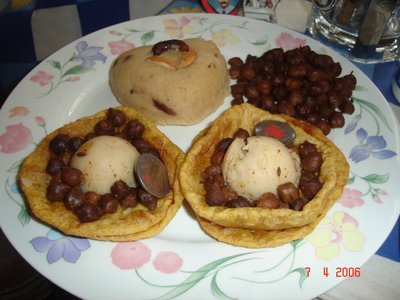NavRatri - The Festival Of Nine Nights
Yesterday (7th April, 2006) was Ram Navami. Navratri basically means "Nine Nights" ("Nav" meaning nine and "Ratri" meaning nights). It is a prominent Hindu festival and devoted to Goddess Durga. Navratras, are celebrated twice in a year. The first one observed in April-May (Chaitra month) end with Ram Navami and the second in September-October (Ashwani month) end with Dussehra. Incidentally, these two periods mark the beginning of summer and winter seasons. Sri Ram is worshipped during the first Navratras whereas Maa Durga in the second Navratras.
" Durga Pooja" celebrated with much fervour in the state of West Bengal and the Gujrati Garba/Dandiya are associated with the Ashwani Navratras. The March/April period celebration of the Chaitra Navratras are somewhat toned down and on a smaller scale.
Back in North India ( where I hail from), the Navratras during the summer is associated with a period of fasting for 7 days. The devotees break their fast on the eight day or Ashtami. Since childhood I've seen my grandma and my mum calling little girls - called Kanjaks to our house on this day. These young girls are symbolic of the Goddesses that they had been worshipping in the past 7 days. Their feet are washed, worshipped and are then offered the traditional "Poori, Halwa and Kaala Chana" and are usually given some token money along with some small knickknack like bangles, red chunnis etc. I still remember when as children we were made to feel so important and we had "appointments" to visit this Aunty's place at so and so time and that Aunty's place at that time for this traditional custom :). The ninth day Navami ends this period and is celebrated as Ram Navami.
We've been thinking for quite some time to visit the shrine of Mata Vaishno Devi in J&K but our plans don't seem to materialise. It is the busiest during these two times of the year - during Navratras. Lets see when we cam make the trip :)
I've stopped fasting since a couple of years but do try to make the traditional fare of "Poori, Halwa and Kaala Chana" on Ashtami if I can. And as I was running around in the kitchen this time, I got all nostalgic....I remember when in hostel, how we used to religiously keep fasts and observe the Navratras. The 'religious' angle was involved but I guess it was more of a way to detox our bodies! Nine days of fasting, living on just juices, fruits, salads etc, yoghurt - it worked wonders on our system and we usually ended up feeling good about ourselves at the end of it!! Those were some days.....
So, it was Kaddu Ki Poori, Sookhe Kale Chane and Sooji Ka Halwa for breakfast on Ashtami this year for us. It's a lovely combination - Halwa, Poori and Chane - and can be had as a weekend breakfast too!!

These dishes can be made in a jiffy and its not that their recipes are very elaborate and I can do away with having to detail them out here - but no! I shall still go ahead and do it...after all I'm keeping a tab on what I cooked through this blog!
why are there coins in your food?
Dish you wash them first, they passed through many hands..
Posted by tris |
6:26 PM
tris |
6:26 PM
Can you please share the recipe for the black chana curry that you have photographed above ?. I was in the north when I was young, and remember that it tastes awesome. I would like to try it out.
-BB
Posted by Anonymous |
2:16 PM
Anonymous |
2:16 PM
Hello BB,
The Black Channa Curry that you are talking of in the above photograph is not a curry - its just a dry preparation using these kala channas. You can have a look at its recipe on: http://memoirsfrommykitchen.blogspot.com/2006/04/sookhe-kaale-chane-ashtami-waale.html. Let me know how they turned out.
Posted by Shilpi |
11:00 PM
Shilpi |
11:00 PM
Hi Tilotama,
Yes, I did wash the coins first! The coins are there in the plate as these were used for offerings to the Gods during Pooja on Ashtami when I had made these pooris, chanas and halwa - and I thought it would be nice to photograph them as it is!
Posted by Shilpi |
11:04 PM
Shilpi |
11:04 PM